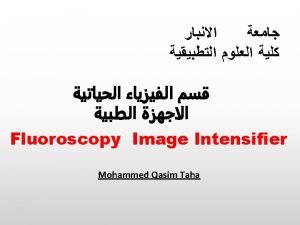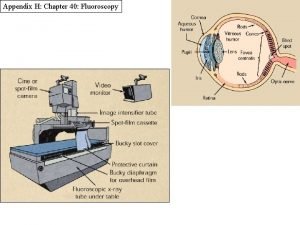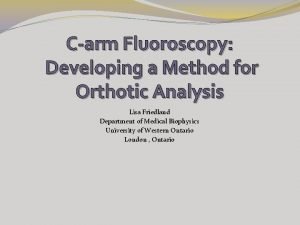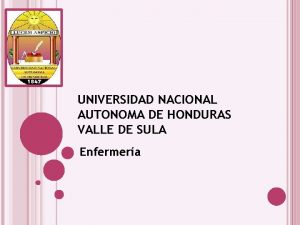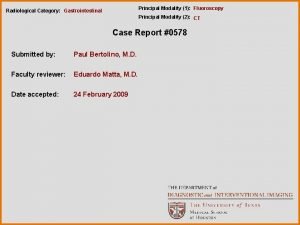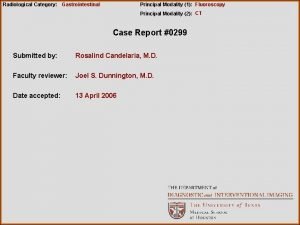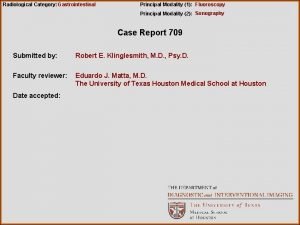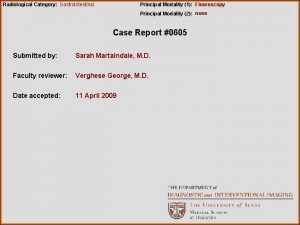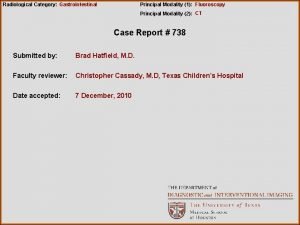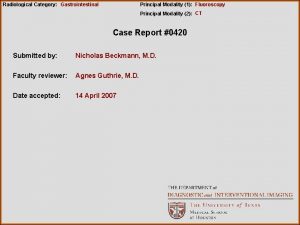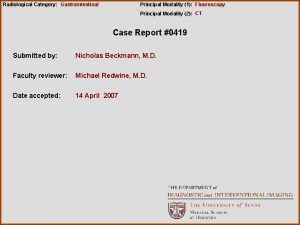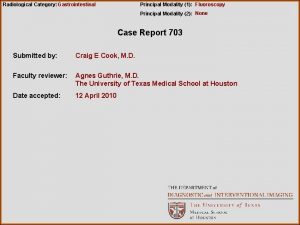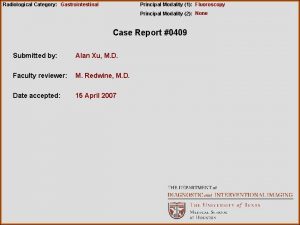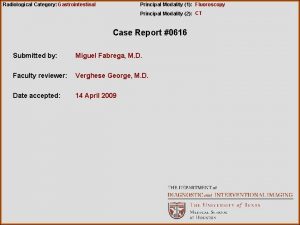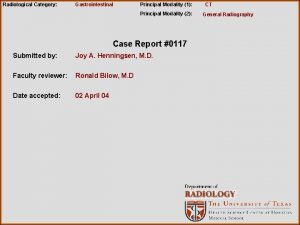Radiological Category Gastrointestinal Principal Modality 1 Fluoroscopy Principal












- Slides: 12

Radiological Category: Gastrointestinal Principal Modality (1): Fluoroscopy Principal Modality (2): None Case Report #0306 Submitted by: Bhumi Rawal, M. D. Faculty reviewer: Agnes Guthrie, M. D. Date accepted: 13 April 2006

Case History Middle-aged female with history of liver disease presents with guaic positive stool.

Radiological Presentations Image 1

Radiological Presentations Image 2

Radiological Presentations Image 3

Test Your Diagnosis Which one of the following is your choice for the appropriate diagnosis? After your selection, go to next page. • Reflux esophagitis • Varicoid type of esophageal carcinoma • Lymphoma • Esophageal varices

Findings and Differentials Findings: Thickened esophageal folds extending from GE junction up to mid esophagus. Good distensibility of esophageal lumen with fewer folds seen during distention of esophagus (Image 2). No esophageal ulcerations or nodules identified. No gastroesophageal reflux identified during exam. Prominent splenic shadow (depicted by arrows on Image 3). Differentials: • Reflux esophagitis • Varicoid carcinoma • Lymphoma • Esophageal varices

Discussion The differential for thickened esophageal folds is esophagitis, varicoid carcinoma, lymphoma, and esophageal varices. Reflux esophagitis can cause thickened esophageal folds, which are most easily demonstrated when the esophagus is collapsed. However, this patient did not report a history of reflux and no reflux was observed during the study. Other findings often seen with reflux esophagitis such as hiatal hernia, granular mucosa, or ulcerations were also not present. Varicoid carcinoma is a form of esophageal squamous cell carcinoma. It infiltrates submucosally and spreads superficially, causing thick, tortuous, longitudinal folds which are rigid and persistent. The folds in this case are not persistent and the esophagus distends well, ruling against this diagnosis. Lymphoma may thicken esophageal folds by infiltrating submucosa. Submucosal nodules are often seen. However, it rarely affects the esophagus.

Discussion Esophageal varices are dilated blood vessels within the wall of the esophagus. They are responsible for ~5 -11% of upper GI bleeds. Varices may be uphill (enlarged portosystemic collateral veins due to portal hypertension and usually present in distal esophagus) or downhill (occur as result of superior vena cava obstruction and usually present in proximal esophagus). On fluoroscopic barium study, esophageal varices produce serpiginous filling defects (thickened esophageal folds) that change in size with intrathoracic pressure changes and collapse with esophageal peristalsis and distention. These thickened folds have smooth surfaces versus the irregular surfaces seen with varicoid carcinoma. CT and MRI are also effective in demonstrating varices.

Discussion In this case the patient reported liver disease and a prominent splenic shadow is identified. UGI also demonstrated prominent gastric folds, representing gastric varices (also seen on Image 2).

Discussion References: Brant WE. Pharynx and Esophagus. In: Brant WE, Helms CA (eds). Fundamentals of Diagnositc Radiology. Lippincott, Philadelphia, 1999; 716 -18. Emedicine. com. Esophageal Varices. [updated 12 Apr 2006; cited 12 Apr 2006]. Available from http: //www. emedicine. com. Rubesin SE, Levine MS. Differential Diagnosis of Esophageal Disease on Esophagography. Applied Radiology October 2001; 11 -21.

Diagnosis Esophageal varices (uphill varices)
 Digital fluoroscopy vs conventional fluoroscopy
Digital fluoroscopy vs conventional fluoroscopy Erate category 2
Erate category 2 National radiological emergency preparedness conference
National radiological emergency preparedness conference Radiological dispersal device
Radiological dispersal device Tennessee division of radiological health
Tennessee division of radiological health Center for devices and radiological health
Center for devices and radiological health Optical coupling in fluoroscopy
Optical coupling in fluoroscopy Bronchoscopy fluoroscopy
Bronchoscopy fluoroscopy Spot film device fluoroscopy
Spot film device fluoroscopy Carm fluoroscopy
Carm fluoroscopy Motilidad gastrointestinal
Motilidad gastrointestinal Emt chapter 18 gastrointestinal and urologic emergencies
Emt chapter 18 gastrointestinal and urologic emergencies Dr sigit djuniawan
Dr sigit djuniawan






